Rane CM 86 Handleiding
Rane
Mengpaneel
CM 86
Bekijk gratis de handleiding van Rane CM 86 (4 pagina’s), behorend tot de categorie Mengpaneel. Deze gids werd als nuttig beoordeeld door 9 mensen en kreeg gemiddeld 4.9 sterren uit 5 reviews. Heb je een vraag over Rane CM 86 of wil je andere gebruikers van dit product iets vragen? Stel een vraag
Pagina 1/4

OPERATING / SERVICE MANUAL
CM 86
QUICK START
Think of this like a fortune cookie: you have to read the saying before you eat it. But unlike a fortune cookie we don’t
want you to break your CM 86 before getting the message. So here’s your fortune:
Rane adheres to the AES/ANSI/IEC standards of pin 2 positive, pin 3 negative and pin 1 ground. Choose between either
the 3-pin (XLR-type) or the terminal strip MIC IN. Use only ONE; they are in parallel and do NOT sum. The LINE IN
(unbalanced 1/4") is grounded when not used. This allows the MIC/LINE switch to act as an input MUTE switch when-
ever the LINE IN jack is not used. Likewise, if it is used then the MIC/LINE switch acts like a true source selector.
Set
the rear-mounted MIC GAIN control as necessary for your mic. Use the OL indicator as an adjustment aid: increase gain
until this LED occasionally lights. Optimum noise performance results from taking as much gain as possible. (The OL indi-
cator on the front panel parallels the one on the rear.) Select PHANTOM POWER as needed for each channel indepen-
dently. When setting channel equalization, use the IN/OUT switch to compare equalized with unequalized material.
When using the AUX A/B level controls, remember to set the desired take-off location using the PRE/POST switches.
PRE takes this signal before the Channel LEVEL controls, allowing independent operation of both. POST takes this signal
after the Channel LEVEL controls, allowing the LEVEL controls to turn the Aux levels up/down simultaneously. Set the
OUTPUT SELECT to assign each input channel to the desired output. Choose between “A” only, “B” only or “AB” both.
Note that choosing only one, say “A,”
routes this input to both MASTER 1A and MASTER 2A outputs, but nothing goes
to either B output.
When setting input AUX A/B and LEVEL A/B controls, keep an eye on the appropriate PRE-OUTPUT OVERLOAD in-
dicators. They monitor overloading of the critical summing stages. Use the METER & HEADPHONE ASSIGN switch to
select the desired output for metering and monitoring. The HEADPHONE connects to the same point as the OUTPUT ME-
TERS — what you see is what you hear.
Read the Rane FLEX USERS GUIDE for details about the Flex DIN connectors. Expansion and augmentation of the CM
86 is easily done using this handy bus. TAPE OUT is taken after the MASTER INSERT LOOPS and before the MASTER
1 & 2 OUT LEVEL controls. The MASTER INSERT LOOPS do not affect the AUX A & B outputs. All four MASTER
OUTS are driven by high-current cross-coupled line drivers which will drive lines 1000 feet (305 meters) using Belden
8451 or equal wire.
Miscellaneous: The CM 86 does NOT invert signals. Use the LIFT (ground lift) switch to help eliminate stubborn hum
problems. NEVER CONNECT ANYTHING EXCEPT AN APPROVED RANE RS 2 (the big one) POWER SUPPLY
TO THE RED JACK ON THE REAR OF THE UNIT.
Good fortune and great wealth are coming your way.
SYSTEM CONNECTION
When first connecting the CM 86, LEAVE THE POWER SUPPLY FOR LAST. This gives you a chance to make mis-
takes and correct them without damaging your fragile speakers, ears and nerves.
INPUTS. Each input channel has two MIC IN connectors. The 3-pin (XLR-type) connector and the terminal strip are wired
in parallel and either one works equally well; however, they do NOT sum. USE ONLY ONE. Choose strictly from a re-
quired hardware point-of-view, there is no performance trade-off. Wiring convention conforms to the AES/ANSI/IEC stan-
dard of pin 2 positive, pin 3 negative and pin 1 ground, with the shell being tied to chassis. Microphones requiring Phantom
Powering must tie pin 1 to the shield, otherwise the Phantom Power circuit is not completed. The LINE IN is an unbalanced
1/4" jack, and may be used in conjunction with the MIC IN. The MIC/LINE switch then operates as a selector switch. When
(continues on last page...)

FRONT PANEL DESCRIPTION
1. INPUT SOURCE SELECTOR. This slide switch selects between MIC or LINE inputs. Both inputs may be used; in
which case this switch acts as a true source selector. If the LINE input is not used then it is internally grounded and this
switch acts like a Mic Mute when moved to the LINE position.
2. INPUT OVERLOAD INDICATOR. This red LED parallels an identical one in the rear and monitors all critical input
nodes. It lights whenever these levels exceed 4dB below clipping. Occasional flickering is normal; however., it should not be
allowed to light steadily.
3. INPUT EQUALIZATION CONTROLS. A two-band shelving LOW (bass) and HIGH (treble) tone control circuit.
These controls adjust the frequency contour of both MIC and LINE inputs. The EQ is located before the INSERT LOOP.
4. EQ IN/OUT ENGAGE SWITCH. This slide switch controls the EQ circuits. Useful for comparing equalized (IN) with
unequalized (OUT) signals, or for guaranteeing flat frequency response (OUT).
5. PRE/POST AUX-ASSIGN SWITCHES. These slide switches allow choosing the AUX take-off points. Selecting PRE
places the AUX Level before the Channel LEVEL controls, thus allowing independent operation between the two. Selecting
POST takes the AUX Level after the Channel LEVEL controls, thereby allowing the LEVEL controls to affect all outputs.
6. AUX CONTROLS. Separate controls for mixing the input channel into the AUX A and AUX B Output (Send) signals.
7. OUTPUT SELECT SWITCH. A three-position slide switch that selects routing of this input channel. Choosing either
“A” or “B” puts all of this signal into only the A or B outputs. Choosing “AB” puts this signal equally into both.
8. CHANNEL LEVEL A/B CONTROLS (Input Faders). Concentric controls used to set the amount of signal mixed into
the MASTER A and B outputs.
9. TAPE/CD MIX CONTROLS. Three rotary controls that set the amount of the Tape, Tuner, or CD input signals mixed
in with the AUX A, AUX B or MASTER outputs.
IO. AUX IN/RETURN LEVEL CONTROL. Concentric knobs that control the amount of AUX signal coming into the
AUX OUT/IN jacks (on the ring). Often the return path from an effects box in the AUX OUT/IN LOOP; or alternatively, it
may control a separate AUX input.
11. AUX OUT/SEND LEVEL CONTROL. Concentric knobs that control the amount of AUX signal coming out of the
AUX OUT/IN jacks (on the tip). Often the send path for an effect box in the AUX OUT/IN LOOP; or alternatively, it is the
AUX output level.
12. PRE-OUTPUT OVERLOADS. LED indicators monitoring the four critical summing stages (Master A/B and Aux
A/B). They light 4dB before actual clipping. Occasional blinking is okay, but do not allow them to light steady.
13. MASTER 1 OUT STEREO/MONO SWITCH. A slide switch used to mono the MASTER 1A & 1B outputs.
14. MASTER 1 OUTPUT LEVEL CONTROLS. Concentric controls used to set the desired output level.
15. MASTER 2 OUT STEREO/MONO SWITCH. A slide switch used to mono the MASTER 2A & 2B outputs.
16. MASTER 2 OUTPUT LEVEL CONTROLS. Concentric controls used to set the desired output level.
17. METER & HEADPHONE ASSIGN SWITCH. A three-position slide switch used to choose between MASTER
1A/1B, MASTER 2A/2B or AUX A/B outputs for monitoring by the OUTPUT METERS and HEADPHONE circuits.
18. POWER INDICATOR. A yellow LED that lights whenever proper power is applied to the CM 86.
19. HEADPHONE JACK. A standard 1/4" jack for stereo headphones. This allows headphone monitoring of whatever out-
put is selected. Standard wiring convention is followed, i.e., Tip=Left ear= Channel A, and Ring=Right ear=Channel B.
20. HEADPHONE LEVEL CONTROL. Used to set the desired headphones listening level.
21. OUTPUT METER. A two-channel 6-segment peak responding LED meter accurately calibrated in dBu units.

REAR PANEL DESCRIPTION
1. PHANTOM POWER SELECTOR SWITCH. Turns the microphone Phantom Power voltage ON and OFF.
2. INPUT OL (OVERLOAD) INDICATOR. This red LED is identical to one on the front panel and monitors all critical
input nodes. It lights when these levels exceed 4dB below clipping. Some flickering is normal; it should not light steadily.
3. MIC GAIN TRIM CONTROL. A rotary control used to set the correct gain required by your microphone.
4. 3-PIN MICROPHONE INPUT CONNECTOR. Pin 2 is positive, pin 3 is negative and pin 1 is signal and shield
ground. This connector is in parallel with the terminal strip below. USE ONLY ONE — THEY DO NOT SUM.
5. TERMINAL STRIP MICROPHONE INPUT CONNECTOR. Parallels the 3-pin connector above.
6. LINE INPUT CONNECTOR, 1/4" UNBALANCED (mono) input connector. Use for any line-level source. This input
is automatically grounded when not used.
7. INPUT CHANNEL INSERT LOOP. This jack allows any outboard unit to be patched in-series with the input signal.
LOCATED POST-EQ. Wired per standard tip=send/rimg=return convention. Automatically bypassed when not used.
8. AUX OUT/IN JACKS. A pair of UNBALANCED 1/4" TRS jacks used for either AUX OUT alone, or as a Send/Re-
ceive (Out/In) effects loop for recording and other applications. For AUX OUT, use a standard MONO unbalanced 1/4" plug
(the IN function is automatically grounded). For effects loop use, this jack follows the standard tip=send (out) / ring=receive
(in) wiring convention. Very clever (or desperate) users make use of this jack as a direct input to the Master summing net-
works. To do this, use a 1/4" TRS plug wired with the input signal going to the RING and leave the TIP open (unused).
9. TAPE/CD INPUT MONO PUSHBUTTON. Used to mono whatever source is connected to the RCA input jacks.
10. TAPE/CD RCA INPUTS JACKS. A pair of RCA jacks used to connect a Tape player, Tuner, CD player, or any line-
level source requiring this type of jack. Sums directly into the Aux and Master mixing buses via the Level controls on front.
11. TAPE OUTPUT RCA JACKS. A pair of RCA jacks used to connect a Tape Recorder. This output signal is located
AFTER the Master Insert Loops and BEFORE the Master Output Level controls.
12. FLEX BUS IN & OUT CONNECTORS. A pair of 7-pin DIN jacks used to expand to another CM 86, or to augment
input/output features by adding any of the Flex Modules using the Flex Bus. See the Rane FLEX USERS GUIDE for details.
13. MASTER INSERT LOOP JACKS. 1/4" TRS jacks wired tip=send/ring=return used to add any outboard effects unit
in series with all the Master Outputs. Located BEFORE the Tape Out jacks.
14. MASTER 2 A & B OUTPUT 3-PIN CONNECTORS. Pin 2 is positive, pin 3 is negative and pin 1 is signal ground.
Do NOT use pin 1 for true balanced interconnection; tie shield at one end ONLY. Unbalanced use requires grounding of pin
3, i.e., tie pin 3 to pin 1.
15. MASTER 1 A & B OUTPUT TERMINAL STRIP. Do NOT use COMMON GROUND for true balanced intercon-
nection; tie shield at one end ONLY. Unbalanced use requires grounding of negative (“–”) output, i.e., tie the “–” and COM-
MON GROUND terminals together.
16. GROUND LIFT SWITCH. Provides the ability to separate chassis and signal grounds. Do not move this switch with
your power amplifiers turned on and up.
17. REMOTE POWER SUPPLY INPUT. The unit is supplied with the large Model RS 2 Remote Power Supply. NEVER
USE A POWER SUPPLY OTHER THAN THE ONE SUPPLIED OR A REPLACEMENT APPROVED BY RANE COR-
PORATION.
18. CHASSIS GROUND POINT. Used for chassis grounding purposes. See CHASSIS GROUNDING on the last page for
details.
Product specificaties
| Merk: | Rane |
| Categorie: | Mengpaneel |
| Model: | CM 86 |
Heb je hulp nodig?
Als je hulp nodig hebt met Rane CM 86 stel dan hieronder een vraag en andere gebruikers zullen je antwoorden
Handleiding Mengpaneel Rane

18 Juni 2025
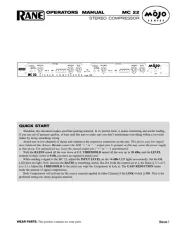
18 Juni 2025
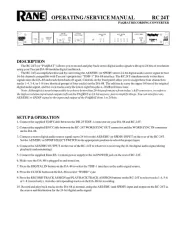
18 Juni 2025
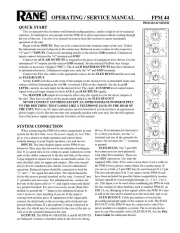
17 Juni 2025
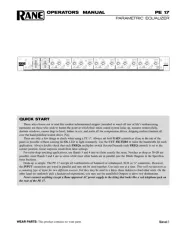
17 Juni 2025
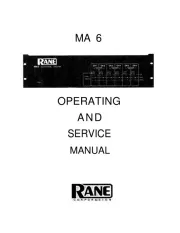
17 Juni 2025
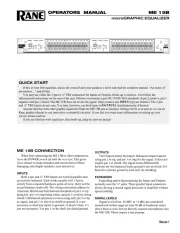
17 Juni 2025
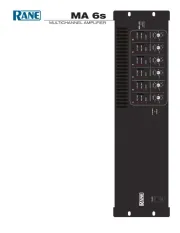
17 Juni 2025
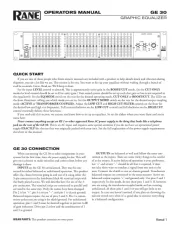
17 Juni 2025
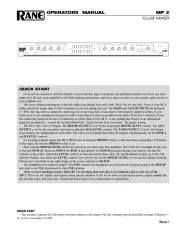
17 Juni 2025
Handleiding Mengpaneel
- M-GAME
- Heritage Audio
- Ion
- Comfee
- SPL
- DS18
- Monoprice
- SSL
- Nedis
- DBX
- Citronic
- Sonifex
- Sencor
- Aviom
- Tascam
Nieuwste handleidingen voor Mengpaneel
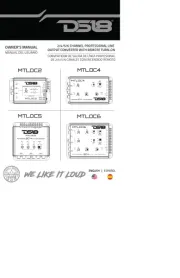
8 September 2025
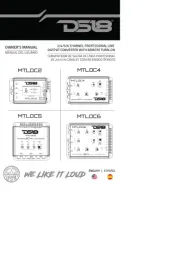
8 September 2025
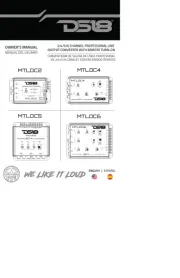
8 September 2025
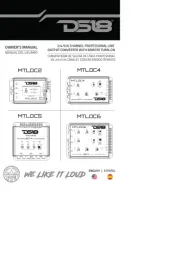
8 September 2025
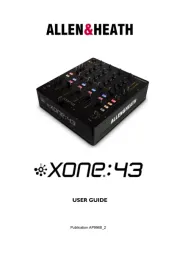
12 Augustus 2025
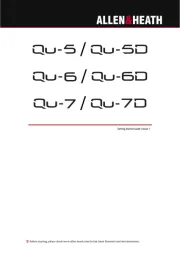
12 Augustus 2025
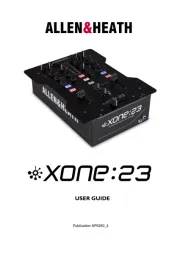
11 Augustus 2025
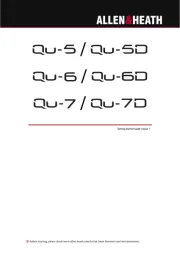
11 Augustus 2025
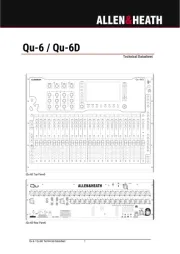
11 Augustus 2025
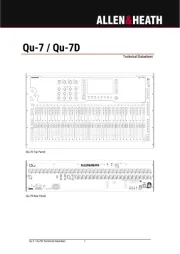
11 Augustus 2025